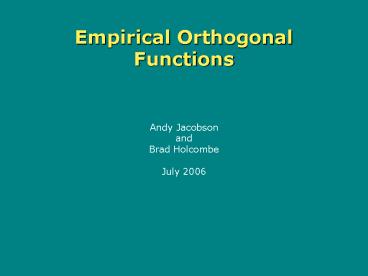Empirical Orthogonal Functions - PowerPoint PPT Presentation
1 / 13
Title:
Empirical Orthogonal Functions
Description:
Empirical Orthogonal Functions Andy Jacobson and Brad Holcombe July 2006 Variance and Covariance Eigenvalue Decomposition Eigenvalue Decomposition Eigenvalue ... – PowerPoint PPT presentation
Number of Views:160
Avg rating:3.0/5.0
Title: Empirical Orthogonal Functions
1
Empirical Orthogonal Functions
Andy Jacobson and Brad Holcombe July 2006
2
Variance and Covariance
- Notes
- E() is expectation (mean)
- M is the number of obs
- N is the number of stations (locations with
data) - All vectors are arranged in columns unless
transposed. - If computing var/cov by hand, you must remove
the mean of the data at each station. - Degrees of freedom M are reduced by one because
of the computation of the mean. - D is the data matrix
- The spatial dimensions of your input data must
be unwrapped 2-D grids must be laid out as a
1-D row in D - C is the covariance matrix.
3
Eigenvalue Decomposition
- Two covariate time series, x and y.
- Generated from two uncorrelated random number
sequences by multiplying by a specified
covariance matrix.
4
Eigenvalue Decomposition
- Notes
- C is the covariance matrix
- E is the matrix of eigenvectors
- ? is the diagonal matrix of eigenvalues
5
Eigenvalue Decomposition
- Notes
- C is the covariance matrix
- E is the matrix of eigenvectors
- ? is the diagonal matrix of eigenvalues
6
Eigenvalue Decomposition
- Notes
- C is the covariance matrix
- E is the matrix of eigenvectors
- ? is the diagonal matrix of eigenvalues
7
Eigenvalue Decomposition
- Notes
- C is the covariance matrix
- E is the matrix of eigenvectors
- ? is the diagonal matrix of eigenvalues
8
Eigenvalue Decomposition
9
Eigenvalue Decomposition
- Notes
- C is the covariance matrix
- E is the matrix of eigenvectors
- ? is the diagonal matrix of eigenvalues
10
Eigenvalue Decomposition
- Notes
- C is the covariance matrix
- E is the matrix of eigenvectors
- ? is the diagonal matrix of eigenvalues
11
Eigenvalue Decomposition
- Notes
- C is the covariance matrix
- E is the matrix of eigenvectors
- ? is the diagonal matrix of eigenvalues
12
EOFs
- Notes
- EOF terminology is not well defined. Conflicting
definitions are common in the literature. - The projection of each eigenvector onto the data
gives a time series of scores. - A is the matrix of score time series and has
dimensions M x N - Principal components often refers to the
scores. - PCA, however, is sometimes taken to mean an
eigen decomposition of the correlation matrix. - The observations from any given time can be
recovered with a weighted sum of the eigenvector
scores from that time (row)
13
EOF Examples
- Retrieving the magnitude and time series of two
static patterns - Effects of noise, missing data, and few data
- Interpretation
- Propagating features
- NAO example
- Exercise ENSO

